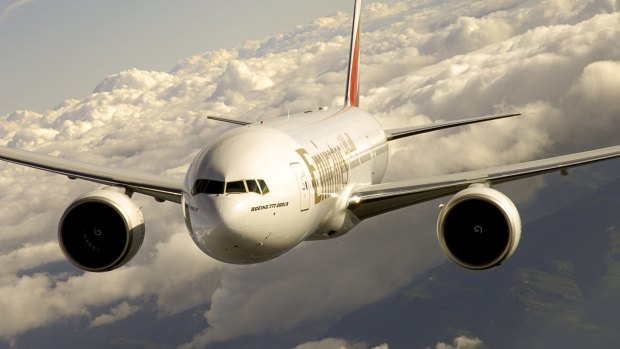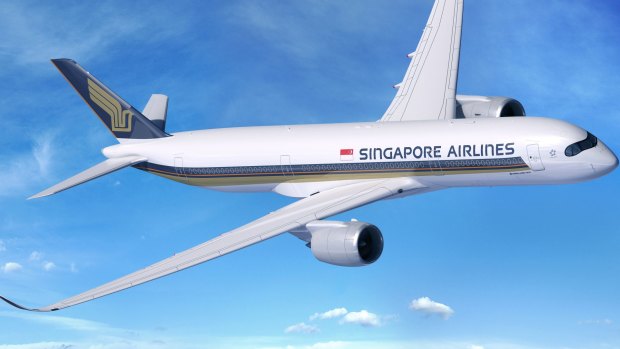This was published 7 years ago
World's longest nonstop flight: Could you survive an 18-hour long haul flight?
By Mary Ann Anderson

Emirates will fly its Boeing 777-200LR from Dubai to Auckland.
As long flights go, Singapore Airlines' epic almost-19-hour, 15,344km journey from Newark to Singapore was once the standard-bearer against which all others were measured. But the all-business-class Flight 21 was scrubbed in 2013, some nine years after its first voyage in 2004. The airline had sold its ultra-long-range A340-500 aircraft, and no other in its fleet was capable of connecting Singapore and the New York area on a nonstop basis.
Today, two airlines share the distinction of the world's longest nonstop flight, according to air-travel intelligence analysts OAG. It's a tie between Emirates Flight 449 from Dubai to Auckland, New Zealand, and Air India from San Francisco to New Delhi. Both clock in at 17 hours and 15 minutes, although the Dubai-Auckland mileage is considerably longer - 14,193km compared with 12,376.
A slightly longer flight on Emirates from Dubai to Panama City at 17 hours and 35 minutes was scheduled to begin in February but has been delayed until later this year or early 2017.

Singapore Airlines will use its A350-900 jets to re-start the world's longest nonstop flights.
See also: How to survive a long-haul flight
In any case, Singapore Airlines will once again one-up its long-haul competitors when it resumes nonstop service from New York to Singapore in 2018, as it announced last fall. That's when the airline will take delivery of the first of seven A350-900 ultra-long-range aircraft, with service to begin shortly after delivery.
Expected flying time will again be between 18 and 19 hours, depending on factors such as wind speed and other weather conditions.
But then again, what's a few minutes more or less when it seems as if you've already spent eternity up in the air?
We've come a long way since the first Wright brothers flight stayed aloft for 12 seconds and travelled all of 35 metres. Consider the iconic jumbo-size Boeing 747, first flown commercially in January 1970 by Pan Am between JFK and London Heathrow. The longtime workhorse, still in service, takes off and lands heavy because of its sheer size and uses copious amounts of fuel. Still, for some aviation geeks like me, the 747 remains a gorgeous aircraft with sleek aerodynamic lines and curves.
See also: Best and worst plane seats rated
Today's newer airplanes, including the fuel-efficient Boeing 777s and 787s and Airbus A350s and A380s, are made of lighter materials, such as cutting-edge carbon-fiber composites and aluminum alloys, and can stay in the air much longer than their predecessors.
Of course, when airplanes are able to stay aloft for up to 19 hours, that means we, as passengers, have to as well. Truthfully, the experience isn't all that bad. Before its demise, I flew the Newark to Singapore route on Singapore Airlines. Instead of the scheduled 18 hours and 45 minutes, our flight landed early, after just 18 hours and 30 minutes. (Whoo-hoo!) I've also flown the New York to Johannesburg route on South African Airways for just less than 16 hours nonstop; it now hovers at No. 20 on the list of longest nonstop flights with an official flight time of 16 hours and 10 minutes.
On both flights, fortunately, the food and wine - which is still included in the price of most international long-haul flights - was excellent, which it should be for a trip lasting almost forever. A special treat on the Newark to Singapore route was that we flew over the North Pole, and I was mesmerised by how much snow covered the top of the Earth.
Don't fret that the crews on ultra-long-haul flights might be sleep-deprived zombies, as pilots and flight attendants are swapped out for fresh replacements during all those hours in the air. Secret stairways lead to crew rest compartments that are generally unknown to passengers - and completely off-limits.
As a frequent flier, I prefer the long-haul non-stop flights, even though I'm confined to a pretty small space for a very long time. They shave off several hours of travel time and take away the annoyance of connecting flights and the increased possibility of lost luggage.
"Non-stop operations to southeast Asia and other ultra-long-haul destinations are of particular benefit to corporate travellers," says James Boyd, spokesman for Singapore Airlines. "Some of the feedback we received from them is that they loved the idea of 'found time,' as they called it, in terms of being able to board the aircraft, have dinner, have time for a full night's sleep, watch a couple of movies and still have time to get some work done before arriving at their destination."
The Washington Post
See also: World's longest flight routes
See also: Qatar: Launch of world's longest non-stop flight delayed till 2017
Sign up for the Traveller newsletter
The latest travel news, tips and inspiration delivered to your inbox. Sign up now.